Digital Poster
Preclinical Cancer: Head & Neck
ISMRM & ISMRT Annual Meeting & Exhibition • 10-15 May 2025 • Honolulu, Hawai'i

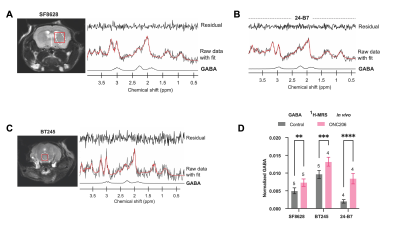 |
Computer Number: 113
1929. GABA
production induced by imipridones is a targetable and imageable
metabolic alteration in diffuse midline gliomas
G. Batsios, S. Udutha, C. Taglang, A. M. Gillespie, B. Lau,
S. Ji, T. Phoenix, S. Mueller, S. Venneti, C. Koschmann, P.
Viswanath
University of Caifornia, San Francisco, San Francisco, United States
Impact: We have developed an integrated metabolic
therapy and 1H-MRS-based
imaging strategy for diffuse midline glioma patients.
Clinical translation of our studies has the potential to
enable precision metabolic therapy and imaging for children
battling this devastating form of brain cancer.
|
|
 |
Computer Number: 114
1930. Repeatability
of quantitative MRI protocol of hypoxia, cellularity, and
perfusion for habitat imaging in a murine glioma model
A. Das, D. Hormuth II, J. Virostko, T. Yankeelov
University of Texas at Austin, Austin, United States
Impact: We have presented updated findings on the
repeatability of our quantitative and multiparametric MRI
protocol for identifying tumor habitats. Our image-derived
quantification of hypoxia, cellularity, and perfusion can
capture tumor heterogeneity at the ROI level.
|
|
 |
Computer Number: 115
1931. T1ρ
as a biomarker for IDH1 mutation status in a glioma mouse model
H. Ehler, S. Sultana, C. Davis, K. Brewer, J. Rioux
Dalhousie University, Halifax, Canada
Impact: T1ρ quantitative imaging shows promise as a
noninvasive biomarker to determine IDH1 mutation status in
glioma. Such a biomarker would allow faster classification,
eliminating the wait time for biopsy results and potentially
improving patient outcome through more personalized
treatment.
|
|
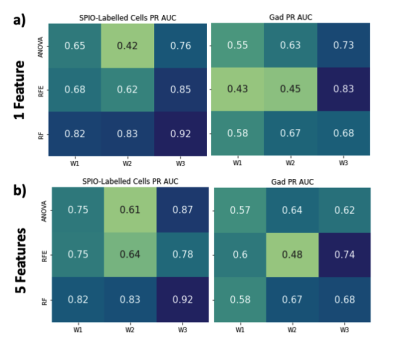 |
Computer Number: 116
1932. MRI
Radiomics Reveals Sex Differences in a Preclinical Model of
Glioblastoma Immunotherapy Response
V. Riberdy, A. Guida, J. Rioux, K. Brewer
Dalhousie University, Halifax, Canada
Impact: Understanding the role of sex-based variations
in therapy response may lead to more effective treatment
monitoring or personalized treatment plans for glioblastoma
and other deadly cancers, ultimately increasing the clinical
relevance and uptake of immunotherapies.
|
|
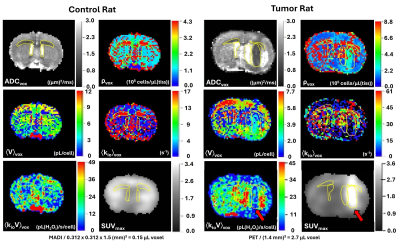 |
Computer Number: 117
1933. Glioma
Glycolysis, and Informed PET Interpretation: Metabolic Activity
Diffusion Imaging (MADI) Tissue Cell Density
J. Schlegel, E. Baker, S. Holland, J. Stoller, W. Packwood,
X. Li, R. Barajas, Jr., C. Springer, Jr., M. Pike
Oregon Health & Science University, Portland, United States
Impact: MADI is compatible with any MRI instrument, and
shows promise for improved tumor detection, improved
metabolic insights, and informing interpretation of other
modality biomarkers. MADI mapping investigations can lead
to deeper insights into in vivo pathology
metabolism.
|
|
 |
Computer Number: 118
1934. Multimodal
imaging to assess treatment effect of a new therapy for
glioblastoma in vivo
M. Al-Gizawiy, R. Wujek, K. Johnson, J. Sidabras, M. Prah,
J. Connelly, C. Chitambar, K. Schmainda
Medical College of Wisconsin, Milwaukee, United States
Impact: Our work seeks to shift current research and
clinical practice paradigms by utilizing a novel and
innovative therapeutic approach to target the iron
metabolism of aggressive primary brain tumors for patients
with limited treatment options.
|
|
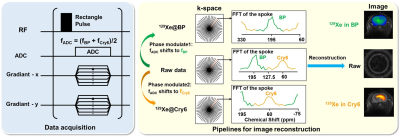 |
Computer Number: 119
1935. In
Vivo Imaging of Xenon Biosensors using Hyperpolarized 129Xe MRI
M. Zhang, H. Li, H. Li, X. Zhao, Q. Zeng, W. Jiang, Y. Yuan,
X. Liu, Y. Zheng, S. Yue, Q. Guo, Y. Han, X. Lou, L-S
Bouchard, X. Zhou
Key Laboratory of Magnetic Resonance in Biological Systems, State Key Laboratory of Magnetic Resonance and Atomic and Molecular Physics, National Center for Magnetic Resonance in Wuhan, Wuhan Institute of Physics and Mathematics, Innovation Academy for Precision Measurement Science and Technology, Chinese Academy of Sciences-Wuhan National Laboratory for Optoelectronics, Huazhong University of Science and Technology, Wuhan, China
Impact: Our findings advance molecular MRI technology by
improving understanding of xenon biosensor distribution and
dynamics. This approach lays the groundwork for future
clinical applications of hyperpolarized xenon biosensors.
|
|
 |
Computer Number: 120
1936. Prediction
based on CE-T1WI imaging omics and pathological parameter models
research on postoperative recurrence of glioma.
Y. Jin, X. Wang, G. Han
NINGXIA MEDICAL UNIVERSITY, Ningxia,China, China
Impact: The established radiomics and pathological
parameter model demonstrate superior performance,
encompassing dimensions from cellular to imaging levels,
thereby providing more comprehensive information. These
models hold substantial potential as pivotal tools for
accurately predicting glioma recurrence, thereby enhancing
prognostic accuracy.
|
|
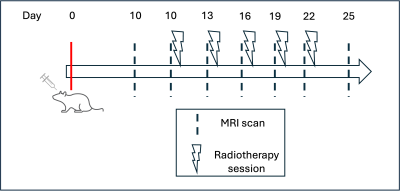 |
Computer Number: 121
1937. Quantifying
longitudinal changes in tumor habitats during radiotherapy via
multiparametric MRI in a murine glioma model: Preliminary
results
A. Das, D. Hormuth II, J. Virostko, T. Yankeelov
University of Texas at Austin, Austin, United States
Impact: Spatial
and temporal changes in the tumor microenvironment impact
treatment efficacy. Our multi
parametric,
quantitative MRI protocol effectively captured shifts in
tumor composition during radiotherapy, offering valuable
insights to improve outcomes.
|
|
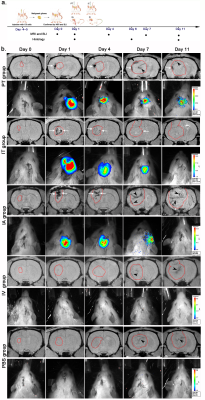 |
Computer Number: 122
1938. Quantification
of the engraftment status of mesenchymal stem cells in glioma
using dual-modality MRI and BLI
Y. Li, Y. Tang, M. Cao, J. Shen
Sun Yat-Sen University, Sun Yat-Sen Memorial Hospital, Guangzhou, China
Impact: FTH and FLUC reporter genes-based MRI and BLI
are practical tools for noninvasively monitoring the
engraftment of MSCs in vivo. Peritumoral delivery of
FTH-FLUC-MSCs offers robust engraftment and could be used as
the optimal delivery route for treating malignant glioma.
|
|
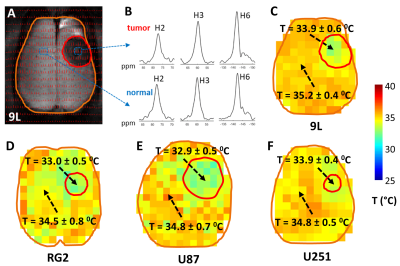 |
Computer Number: 123
1939. Multimodal
imaging reveals gliomas are cooler than normal tissue
D. Coman, P. Herman, J. Rao, J. Mihailovic, Y. Huang, G.
Kaneko, F. Hyder
Yale University, New Haven, United States
Impact:
Temperature regulates the immune response, and thermal- and immuno-therapy might be combined for improved outcome. While temperature is rarely included into discussions related to tumor microenvironment, our results potentially impact future therapeutic directions because cooler conditions enhance tumor growth. |
|
 |
Computer Number: 124
1940. Parameters
from novel non-Gaussian diffusion models for identifying the
expression levels of prognostic factors in nasopharyngeal
carcinoma
H. Ren, J. Zhang, D. Liu, J. Yang, J. Huang, Y. Huang, X.
Ren, H. Yu, Y. Tan, l. Nie
Chongqing University Cancer Hospital, Chongqing, China
Impact: Non-Gaussian diffusion parameters can
non-invasively assess prognostic factors in NPC and help
doctors better manage NPC patients.
|
|
|
Computer Number: 125
1941. Near-infrared
fluorescence imaging with a MET-targeting probe for biopsy site
selection in patients with oral potentially malignant disorders
J. Wang, Q. Ma, Y. Yuan, X. Tao
Shanghai JiaoTong University, Shanghai, China
Impact: This study highlights NIRFI-assisted biopsy as a
promising tool for enhancing early detection in oral cancer
risk. By improving diagnostic precision in OPMDs, it opens
avenues for research into broader applications of NIRFI in
other head and neck cancers.
|
||
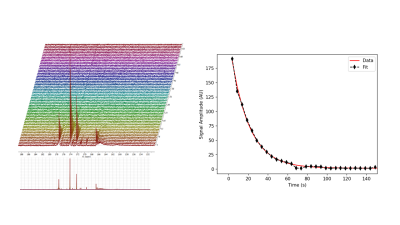 |
Computer Number: 126
1942. Radical-Free
Hyperpolarized α-Ketoglutarate: Non-persistent radicals for
Dissolution DNP
A. Gaunt, J. Lewis, W. Byrne, Y. Kim, X. Ji, D. Vigneron, A.
Comment, J. Gordon
GE Healthcare, San Francisco, United States
Impact: HP photo-irradiated 13C-αKG can provide valuable
metabolic information for assessing low-grade glioma1,
potentially leading to improved diagnostic and treatment
evaluation methods.
|
|
|
Computer Number:
1943. WITHDRAWN |
The International Society for Magnetic Resonance in Medicine is accredited by the Accreditation Council for Continuing Medical Education to provide continuing medical education for physicians.